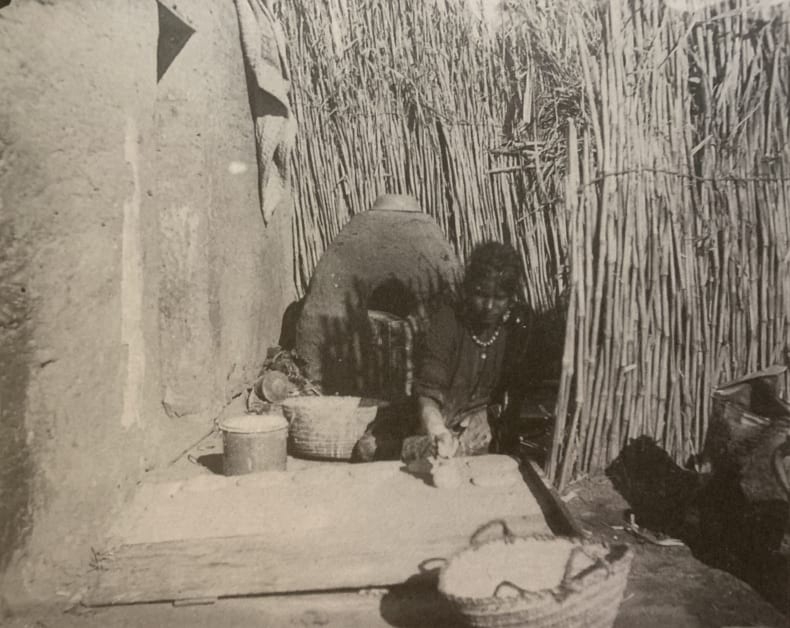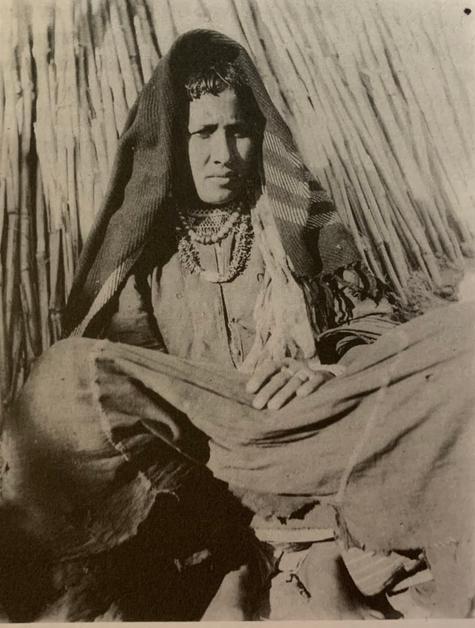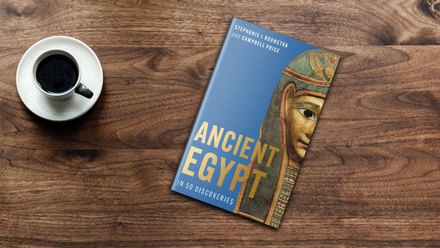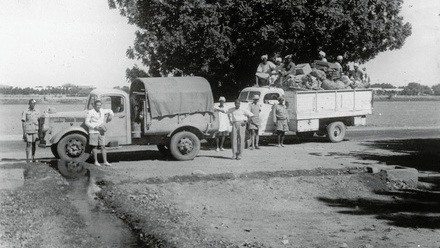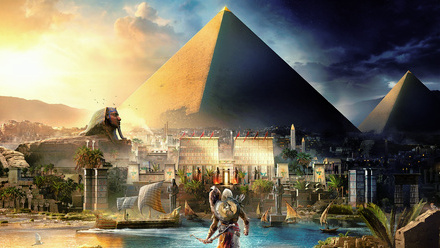The House of Ali Suefi at Armant
by Stephanie Boonstra
In May of 2004, Margaret ‘Peggy’ Drower (1911-2012) donated an oil painting to the Egypt Exploration Society. The panorama-style painting depicts a barren desert in the foreground with a mudbrick and straw house in the middle ground. The background consists of the Nile floodplain and distant mountains fading into the sky. The bottom right corner is signed and dated by the artist ‘V. Manavian 1937’. The back of the painting contains a note from Drower, which includes the title of this piece as ‘The house of reis Ali es Suefi and his family at Armant’ (ART.261).
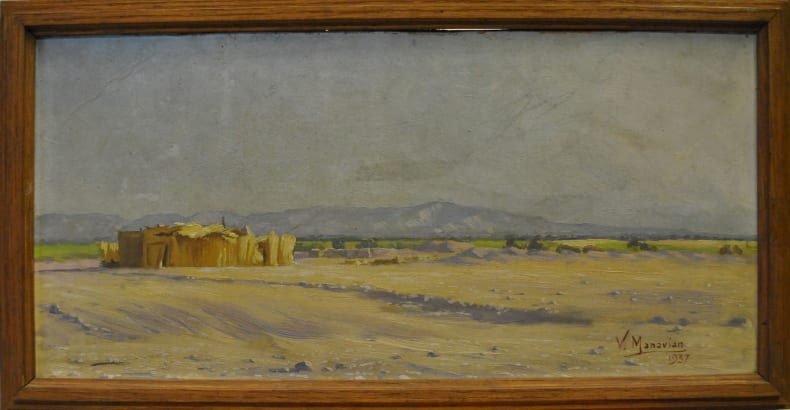
Oil painting ART.261 in the EES archive
While this painting is appreciated for its artistic value, the stories of the two men central to this painting is even more interesting and requires a combination of multiple archives to tell. The lives of these two men and the stories of how a fisherman from Lahun and a young orphan from Istanbul met will be explored.
Ali es Suefi (fl. 1890-1938)
Little is known of the early life of Ali Mohamed Suefi (Ali es Suefi, Aly es-Swefy). In 1890, he began working for William Matthew Flinders Petrie (1853-1942) at the excavations at Meidum, near to the Faiyum village of Lahun where he lived and worked as a farmer and fisherman. Petrie was clearly impressed by the young Ali’s work and brought him along on the following year’s excavations at Tell el-Amarna (1891-92). Ali Suefi’s name appears occasionally in the excavation reports of Petrie but from research into the EES and Petrie Museum archives by Stephen Quirke, we know that Ali played an incredibly important role in the archaeological excavations of both Petrie and other archaeologists over multiple decades from the late 1800s and early 1900s.
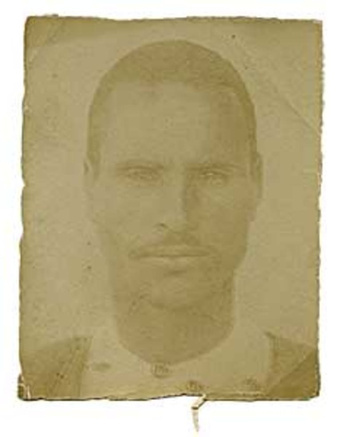
This photo in the Petrie Museum Archive is likely to be of Ali Suefi
(courtesy of the Petrie Museum of Egyptian Archaeology, UCL)
Here are just some of the discoveries that Ali Suefi has been credited with:
- A red jasper foot found in house O47.21 at Amarna (now UC150)
- A delicate gold cylinder amulet from Harageh (now UC6482)
- Cemeteries of al-Riqqa in 1912
- The foundation deposits of the temple of Min and Isis at Koptos
Ali Suefi became Petrie’s ‘right hand man’ and worked as the reis of his large Egyptian workforces. From piecing together correspondence and documents, it is clear that Ali often brought his family along to live with him on excavation. From Flinders and Hilda Petrie's correspondence with London and a photograph album of Margaret Murray (1863-1963) - all in the Petrie Museum Archives - we know the names of Ali’s wives, Fatima and Sara.
Photos of Fatima (left) and Sara (right), the wives of Ali Suefi, from Margaret Murray's 1899-1900 photo album (courtesy of the Petrie Museum of Egyptian Archaeology, UCL)
In the 1920s, Petrie decided to focus his work on archaeological sites in Palestine but by this time, Ali’s archaeological skills and abilities to manage a large workforce were known to many European archaeologists, which led to his employment on other archaeological excavations in Egypt.
Ali Suefi in Armant
During the EES excavations of Armant (1929-38), Ali Suefi again worked as the overseer of the Qufti workforce. Peggy Drower (who also worked on site) noted:
When the E.E.S. decided to excavate the Bucheum, Ali [a]gain took command of the workforce, and it was then that [he] built for himself and his family of two wives and several daughters, a mudbrick house fenced with straw on the gebel just outside the gate of Bucheum House; he was reis in charge of the workforce during the excavation of the cemeteries of Armant (1936-7) and the town of Armant el Heyt (1937-8).
However, before this work, we know that he worked alongside Walter Bryan Emery (1903-1971) during his initial season at Armant in the late 1920s.
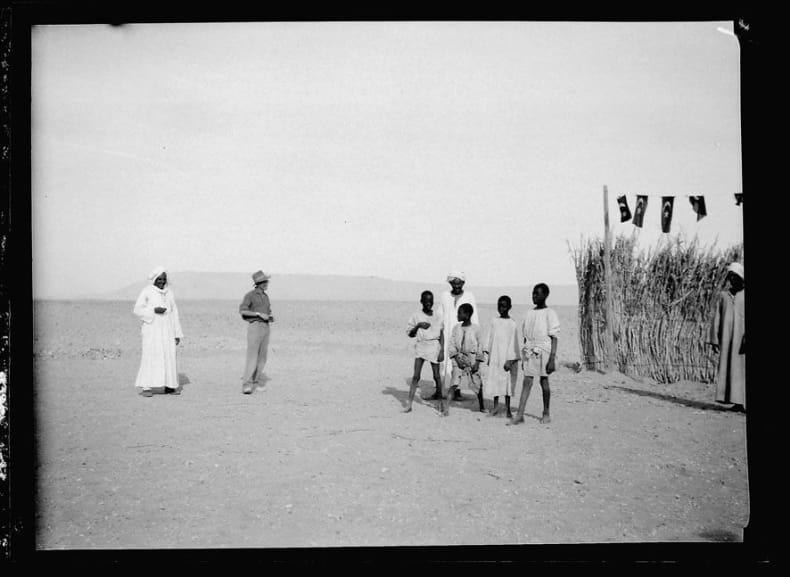
Photograph from Christmas Day 1928 possibly showing part of the house of Ali Suefi on the right in this photo (ARM.NEG.0039)
This is evidenced from a photograph in Emery’s personal photo album (in the EES archive), which is captioned with ‘Ali taking photo’s in the vault’.
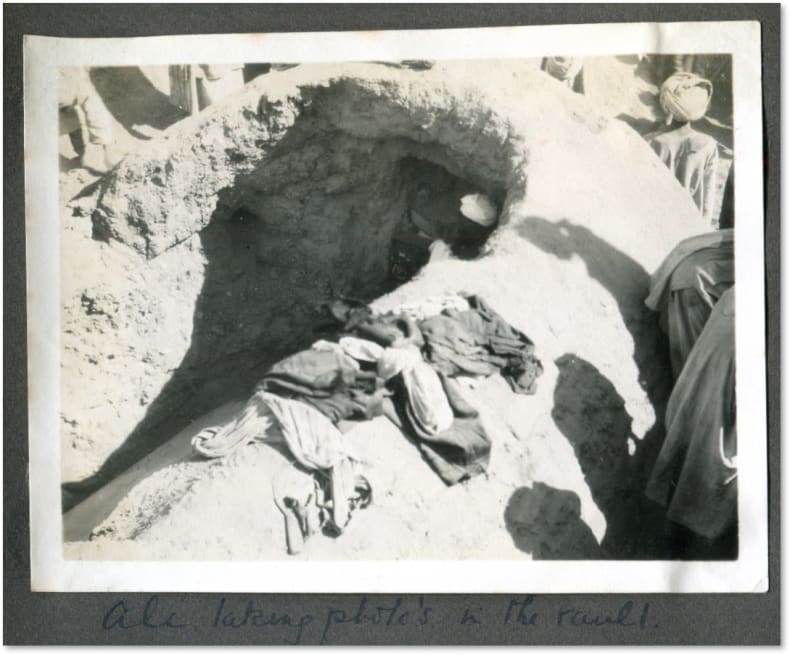
Photo of Ali Suefi in W B Emery's personal album
It is clear that Ali Suefi was very multitalented on archaeological excavations and Drower even mused, ‘I believe that he achieved his ambition to outlive the “Pasha Petrie”’ (ART.261).
Vahram Manavian (1880-1952)
Vahram Manavian was born in Istanbul to a poor family. After the death of his father, he and a brother were sent to live in an orphanage for several years. It was during this time that Vahram cultivated an interest in art and was tutored in it by a conservative Armenian artist named Simon Agopian (1857-1921). While studying at the School of Fine Arts in Istanbul and teaching art at the orphanage, he ‘clashed’ with the Armenian authorities and was exiled by the Ottoman government to Rhodes.
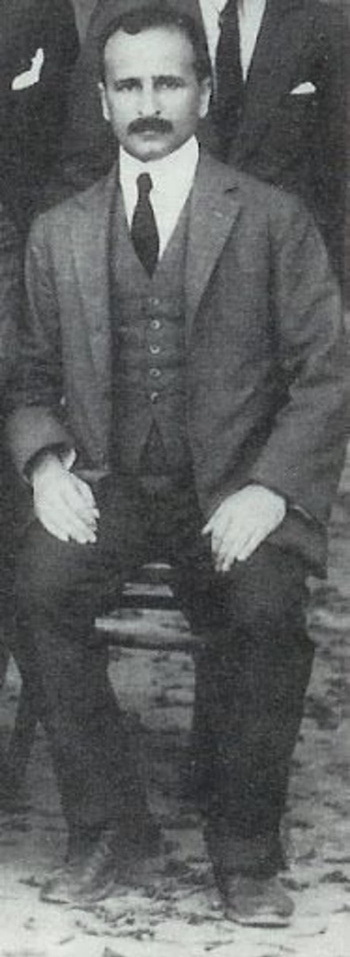
Photo of Vahram Manavian (courtesy of AGBU Egypt)
In 1906, Manavian fled his exile in Rhodes and moved to Alexandria. Over the next decade or so, he moved between jobs and cities in the Mediterranean until he became an art teacher at the Kalousdian Armenian School in Cairo in 1932. He taught there from 1932-36 and again from 1939-41. However, biographies of Manavian omit how he spent his time in the intervening years of 1936-1939 – when he painted ‘The house of reis Ali es Suefi and his family at Armant’.
On the 4th of November 1937, Oliver Myers (1903-1966), co-director of the EES Armant excavation (along with Sir Robert Mond (1867-1938)), wrote, ‘The following staff was engaged in Cairo: … Vahram Manavian, an Armenian, as photographer at £15 per month’. By the 20th of November, Myers noted that ‘the photographer, Monsieur Manavian , not only takes perfect photographs as will be seen, but also is an excellent draughtsman and painter’. He also noted, ‘Manavian has made two excellent reconstruction paintings of Kom el Abd and one of the Osiride’.
This was the final season of work conducted by the EES at Armant, largely due to the advent of WWII and the death of Sir Robert Mond. Thanks to the generous gift of Peggy Drower, the EES has an enduring image of when an Armenian-Egyptian painter and a fisherman turned archaeological powerhouse worked together in Middle Egypt.
Further reading:
‘Vahram Manavian (1880-1952)’, Armenian General Benevolent Union (AGBU) Egypt, http://agbuegypt.com/artist/vahram-manavian/#read-more <accessed 20.04.2020>.
Mohamed Abul-Yazid, 'Ali Swayfi: "Petrie's Best Lad"', The Abydos Temple Paper Archive, https://abydosarchive.org/2017/06/01/ali-swayfi-petries-best-lad/ <accessed 16.07.2020>.
Stephanie L Boonstra and Alix Robinson, ‘Rehousing the EES glass-plate negatives’, Egyptian Archaeology 55: 44-47. An excerpt of this article is available online here.
Sir Robert Mond and Oliver Myers, 1934. The Bucheum, 3 vols. The Egypt Exploration Society: London.
Sir Robert Mond and Oliver Myers, 1937. The Cemeteries of Armant, 2 vols. The Egypt Exploration Society: London. Read online here https://ees.soutron.net/Portal/Default/en-GB/RecordView/Index/2146.
Sir Robert Mond and Oliver Myers, 1940. Temples of Armant. A Preliminary Survey, 2 vols. The Egypt Exploration Society: London.
Stephen Quirke, 2010. Hidden Hands: Egyptian workforces in Petrie excavation archives, 1880-1924. Duckworth: London.
Stephen Quirke, 2015. ‘Ali Suefi of Lahun and the gold cylinder’, in A. Stevenson (ed.), The Petrie Museum of Egyptian Archaeology: Characters and Collections. UCL Press: London. 56-7. Download free here or read online here https://ucldigitalpress.co.uk/Book/Article/3/20/93/

